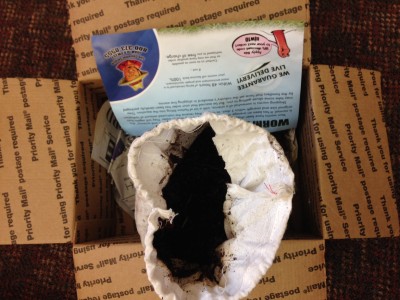The average American tosses about 25% of food and beverages purchased according to a report by the National Resources Defense Council. While this can be cut down by better food planning, recipe selection, and food storage, throwing food in the garbage is sometimes unavoidable. Instead of putting all of my cauliflower stocks, egg shells, and coffee grounds in the plastic garbage bag I decided to try composting instead. Its the 4th R, reduce, reuse, recycle, and ROT.
I limited my choices to homemade aerobic compost or worm compost. Here is how they compared:
Homemade Aerobic Compost
Pros: Can be increased larger and larger and is not limited by a container size.It is free or cheap to setup. It processes yard waste like sticks and leaves.
Cons: finding a spot in the yard that wouldn’t be an eyesore. Kitchen scraps like meat, fat, fish, dairy products, grains or bones shouldn’t be added to the pile, as they are likely to attract animals. Has to be regularly turned.
Worm compost (vermiculture)
Cons: It cannot process yard waste, diary, or meat, and adding citrus may introduce fruit flies.
Pros: The liquid fertilizer (compost tea) can be conveniently dispensed through a spigot if you get the right setup. The compost is well contained and easily accessible supply of compost for plants. The worms are on hand and if they get out of control they can be used to fish or thrown in the garden. It is more readily accessible than a compost pile and can be a smaller scale.
Steps to Worm Composting
- Decide what type of composting you want to do – I decided to go with worm compost and followed the Cooperative Extension guide to “Worms in a Tote“.
- Get Worms – I couldn’t find worms at any of the Fairbanks greenhouses so I ordered them from Uncle Jim’s Worm Farm.
- Rehydrate worms – They lose 70% of their body weight on the trip to Alaska so after they come in the box you have to give them a half a cup of water immediately.
- Prep the tote – We used a rubbermaid tote that was about 2′ l x 3 w ‘ x 1’ h, coated the bottom with 2″ of shredded paper, a bit of potting soil, and some kitchen scraps.
- Feed the worms – worms like eggshells, coffee grounds, stale or moldy bread, tea bags, fruit and vegetable scraps (not citrus) and kitchen paper waste.
Worm composting tips
- Don’t forget to chop your scraps into smaller pieces.
- Check your worms to see how much they need to eat, if you put in too much food the tote gets smelly fast.
- Check the moisture of the tote
- Keep your worms somewhere that isn’t too cold
- Keep the tote somewhere you will see it occasionally so you remember to check on and feed your worms.
The Cooperative Extension has several resources for learning more about composting in Alaska.
About etjohnston
Twitter •
